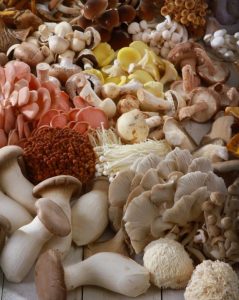First, I learned to pat my chicken dry before I slathered it with butter.
It may sound like a small detail, but that simple step was a game-changer in how I cook.
For years, I rushed through meals, never thinking twice about the basics.
But when I slowed down and took the time to learn these little tricks, the flavor of every dish was elevated.
From then on, every chicken I cooked came out golden and crispy on the outside, juicy on the inside.
Now, when I cook, I think about those small steps—the ones that help me truly savor the food and care for my family’s health.
This week’s recipe collection is full of those little details—just like our Butter-basted Salmon with Portobello Mushrooms, where every ingredient, from the locally sourced salmon to the fresh mushrooms, brings out the best flavors.
Whether you’re using your Market Box ingredients or shopping at Willow Haven General Store, I hope you find these meal ideas as satisfying as that first perfect roast chicken.
Try this Butter-Basted Salmon with Portobello Mushrooms – delicious and filled with nutrition! Click here for the recipe!
MEAL IDEAS FOR YOUR LOCAL ORGANIC FOOD THIS WEEK:
Many of these recipes include produce or other items you may have received in your market box. You may also see ingredients you can purchase at the WHF General Store. Experiment and see what you can use to create your meal plan!
💡Pro tip: Always check your recipes to see what you have and what you need to purchase. Takes a few extra minutes in planning, but it beats finding out at the last minute that you’re missing ingredients!
FEATURED: Chicken Breasts, Salmon, Portobello Mushroom Caps, and Four Monkeys Coffee
Main Dish Meals:
- Our pasture-raised chicken breasts (boneless/skinless) are a healthy and naturally delicious choice. Try a simple baked chicken breast and add your favorite side dishes for a no-fuss meal.
- 💡Tip: Brining your chicken breasts before cooking makes them extra juicy and flavorful. Use a water/salt brine as per the recipe or use leftover pickle juice for a zero-waste option. So good!
- Chicken Breasts with Feta, Celery, and Radish Salad is a perfect 30-minute meal option for weeknights. Prepare as written or try with your favorite vinaigrette.
- Sheet Pan Salmon with Crispy Kale couldn’t be easier! Mix up a quick honey dijon sauce, toss everything on the sheet pan, and dinner is ready in minutes!
Coffee for dinner? Why not? Try these suggestions for using coffee in your cooking:
- Coffee-Rubbed Steak, Chicken, or Salmon – Mix coffee with brown sugar, smoked paprika, salt, and pepper for a bold rub. Prepare with your favorite method.
- Coffee-Braised Short Ribs – Simmer ribs in brewed coffee, broth, onions, and spices for deep flavor.
- Add a splash of coffee to chili for richness and depth.
- Coffee-Marinated Chicken:
- Mix 1 cup brewed coffee (cooled), 2 tbsp soy sauce, 1 tbsp honey, 1 tbsp olive oil, 1 tsp smoked paprika, 1 tsp garlic powder, salt & pepper.
- Add chicken (breast, thighs, drumsticks) and marinate for 2-4 hours.
- Grill or pan-sear until cooked through. Serve with roasted sweet potato fingerlings and a citrusy slaw for balance.
💡Tip: Got leftovers? Use them to plan another meal. Your future self will appreciate it! These suggestions are great for a quick lunch or dinner.
- Leftover Cooked Salmon:
- Salmon Cakes – Mix with breadcrumbs, egg, mustard, and herbs, then pan-fry.
- Salmon Fried Rice – Toss with rice, veggies, soy sauce, and a scrambled egg.
- Salmon & Avocado Toast – Mash avocado on toast, top with flaked salmon, lemon, and chili flakes.
- Salmon Pasta – Toss into a light cream sauce or lemon-garlic olive oil with pasta.
- 💡Tip: Melt chèvre with a bit of milk or cream, butter, and seasonings for a quick cream sauce!
- Salmon Salad – Mix with Greek yogurt or mayo, Dijon, capers, and herbs for sandwiches or lettuce wraps.
- Salmon Tacos – Warm corn tortillas, add salmon, slaw, and a creamy lime sauce.
- Salmon Bowl – Rice (or other grain), crisp veggies (raw, fermented, or cooked will work), and an easy, flavor-popping sauce.
- 💡Tip: Try one of the easy dressings listed below.
- Leftover Cooked Boneless/Skinless Chicken Breasts:
- Chicken Quesadillas – Shred and mix with cheese, salsa, and spices, then grill in tortillas.
- Buffalo Chicken Wraps – Toss in buffalo sauce, wrap in a tortilla with lettuce and ranch.
- Chicken Stir-Fry – Slice and toss with veggies and soy sauce over rice or noodles.
- Chicken Caesar Salad – Chop and add to romaine, Parmesan, croutons, and dressing.
- Chicken & Rice Soup – Dice and simmer with broth, carrots, and rice for a quick soup.
- BBQ Chicken Sliders – Shred, mix with BBQ sauce, and serve on small buns.
Sides:
Try these side dishes to serve with your favorite chicken breast recipe or with the Buttery Salmon recipe above:
- Roasted Carrots with Honey and Thyme: Roast carrots with olive oil, salt, pepper, honey, and thyme at 400°F (200°C) for 20-25 minutes.
- Wilted Spinach (or other greens) with Garlic: Sauté spinach in olive oil and garlic for about 2-3 minutes until wilted, finishing with a pinch of salt.
- Roasted Root Vegetables with Balsamic Glaze: Toss cubed carrots, parsnips, sweet potatoes, and/or beets with olive oil, salt, and pepper. Roast at 400°F (200°C) for 25-30 minutes, flipping halfway. Drizzle with a balsamic reduction before serving.
- Creamy Parsnip Mash: Boil peeled chopped parsnips until tender (about 15 minutes). Drain and mash with butter, a splash of cream or broth, salt, and pepper. Optional: Add roasted garlic for depth.
- Watermelon Radish and Citrus Salad: Thinly slice watermelon radishes and toss with orange segments, arugula, olive oil, lemon juice, and a pinch of salt. Add toasted pumpkin seeds or feta for extra texture.
Dessert:
Love coffee in the morning? Try it for dessert, too!
- Mocha Brownies – Replace some liquid with coffee for a richer chocolate flavor.
- Black Coffee Chocolate Cake (with actual coffee!) – Use brewed coffee in the batter for a super moist result.
Beverages & Miscellaneous:
- Coffee Smoothie – Blend with banana, milk, and cocoa powder.
- Coffee Granita – Freeze sweetened coffee, then scrape with a fork for a slushy treat.
- Espresso Vinaigrette – Mix coffee with balsamic vinegar, olive oil, and Dijon for a bold salad dressing.
- Easy Miso Dressing or Easy Tahini Dressing are great for salads, grain bowls, and more.
- BBQ Sauce with Coffee – Blend brewed coffee into homemade BBQ sauce for smoky complexity.
BREAD:
- Sprouted bagels are great anytime! Choose from four varieties and keep on hand to make breakfast items, sandwiches, and snacks.
- Do not miss Vince’s amazing Maple Bourbon Sourdough Cinnamon Rolls!
DAIRY:
- Amish country butter is delicious and just what you need for your butter-basted salmon recipe.
- Add one (or two) of our many varieties of chevre to your order to use in salads, on bagels, for sauces, and more.
MEAT:
- Our pasture-raised chicken breasts (boneless/skinless) are a healthy and naturally delicious choice. Try a simple baked chicken
- Sockeye salmon fillets or individual portions are perfect for the Buttery Salmon recipe above.
- Try one of Wild for Salmon’s varieties of smoked salmon – delicious on a sprouted bagel with chèvre and onions or capers. (Stop by the general store to pick up capers!)
PANTRY RECOMMENDATIONS:
- Four Monkeys coffee is now available for subscriptions! See the meal suggestions above for ways to use coffee in your cooking!
- Miso, tahini, and coconut milk are all terrific flavor enhancements for this week’s salmon recipe. Add to your pantry items and keep on hand for future recipes!
- We have several flavors of balsamic vinegar for making balsamic glaze. Also great to drizzle on salads and even fruit!
FRUIT:
Storage for all apple varieties:
Keep unwashed apples in a plastic bag in the refrigerator’s crisper drawer, where they can stay fresh for up to two weeks.
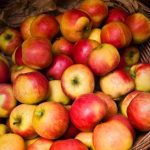 Apple, Crimson Crisp – This variety is known for its deep red skin, crisp texture, and balanced sweet-tart flavor. Crimson Crisp apples are an excellent source of dietary fiber and vitamin C. They also contain antioxidants that contribute to overall health. These medium-sized apples are perfect for fresh snacking, adding to salads, or using in baking due to their firm texture. Their balanced flavor makes them ideal for making applesauce, cider, or pies. Pair slices with cheese or nut butter for a delicious snack.
Apple, Crimson Crisp – This variety is known for its deep red skin, crisp texture, and balanced sweet-tart flavor. Crimson Crisp apples are an excellent source of dietary fiber and vitamin C. They also contain antioxidants that contribute to overall health. These medium-sized apples are perfect for fresh snacking, adding to salads, or using in baking due to their firm texture. Their balanced flavor makes them ideal for making applesauce, cider, or pies. Pair slices with cheese or nut butter for a delicious snack.
 Apples, Golden Delicious – Golden Delicious apples are a versatile variety with a sweet, mellow flavor and a crisp yet tender texture. They are high in fiber, vitamin C, and antioxidants, which support digestion, immune health, and skin health. These apples retain their shape and flavor, making them excellent for eating fresh, baking pies, making sauces, or adding to salads.
Apples, Golden Delicious – Golden Delicious apples are a versatile variety with a sweet, mellow flavor and a crisp yet tender texture. They are high in fiber, vitamin C, and antioxidants, which support digestion, immune health, and skin health. These apples retain their shape and flavor, making them excellent for eating fresh, baking pies, making sauces, or adding to salads.
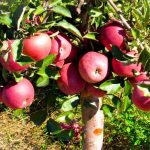 Apples, Pink Lady – Pink Lady apples are a crisp, juicy apple variety with a balanced sweet-tart flavor and a vibrant pinkish-red skin. They are high in fiber, vitamin C, and antioxidants, promoting heart health, immune support, and skin health. Pink Lady apples hold their shape well so they are great for snacking, adding to salads, or baking.
Apples, Pink Lady – Pink Lady apples are a crisp, juicy apple variety with a balanced sweet-tart flavor and a vibrant pinkish-red skin. They are high in fiber, vitamin C, and antioxidants, promoting heart health, immune support, and skin health. Pink Lady apples hold their shape well so they are great for snacking, adding to salads, or baking.
 Grapefruit – Grapefruit is a citrus fruit known for its juicy, tangy-sweet flavor with a slight bitterness. It is rich in vitamin C, fiber, and antioxidants like lycopene, promoting immune health, heart health, and skin health. Grapefruit can be eaten fresh, added to salads, or juiced for a refreshing drink. Store whole grapefruit at room temperature for up to a week or in the refrigerator for up to three weeks.
Grapefruit – Grapefruit is a citrus fruit known for its juicy, tangy-sweet flavor with a slight bitterness. It is rich in vitamin C, fiber, and antioxidants like lycopene, promoting immune health, heart health, and skin health. Grapefruit can be eaten fresh, added to salads, or juiced for a refreshing drink. Store whole grapefruit at room temperature for up to a week or in the refrigerator for up to three weeks.

Lemon – Lemons are tangy citrus fruits packed with vitamin C, antioxidants, and citric acid, which aid digestion, boost immunity, and enhance skin health. They are commonly used to add flavor to beverages, marinades, dressings, and desserts or as a natural cleaning agent. Store lemons at room temperature if using them soon or refrigerate them in a perforated bag to extend their shelf life up to 3-4 weeks.
 Orange, Mandarin – These small, sweet citrus fruits have a thin, easy-to-peel skin. They are high in vitamin C, fiber, and flavonoids, supporting immune function, digestion, and heart health. Mandarins are perfect for snacking, adding to desserts, or tossing into salads. Store them at room temperature for a few days or refrigerate to extend freshness for up to two weeks.
Orange, Mandarin – These small, sweet citrus fruits have a thin, easy-to-peel skin. They are high in vitamin C, fiber, and flavonoids, supporting immune function, digestion, and heart health. Mandarins are perfect for snacking, adding to desserts, or tossing into salads. Store them at room temperature for a few days or refrigerate to extend freshness for up to two weeks.
 Orange, Navel – Navel oranges are sweet, seedless, and easy to peel, making them an excellent snack or addition to salads and desserts. They are high in vitamin C, fiber, and antioxidants, which promote immune health and support heart health. Store navel oranges at room temperature for up to a week or refrigerate them in a mesh bag for up to three weeks to maintain freshness. Wash before peeling or slicing.
Orange, Navel – Navel oranges are sweet, seedless, and easy to peel, making them an excellent snack or addition to salads and desserts. They are high in vitamin C, fiber, and antioxidants, which promote immune health and support heart health. Store navel oranges at room temperature for up to a week or refrigerate them in a mesh bag for up to three weeks to maintain freshness. Wash before peeling or slicing.
Organic Veggies We Harvested This Week:
To help you use everything in your box this week, use this Meal Planning Guide to keep track of what’s in the fridge, what needs to be used first, and what you have planned or prepped for each day.
Every member’s customized Market Box is unique so we hope you will take advantage of more varieties of vegetables as you get comfortable with all the great organic produce we are offering.
Tessa’s Tips
What to use first: greens, mushrooms, green onions
Longest Storage: apples, beets, carrots, potatoes
Pro-tip: Look at the items in your market box right away and decide how you will use them in your meal planning for the week. Freeze any veggies you know you won’t be able to eat in the week.
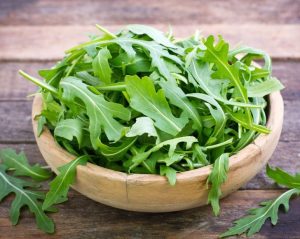
Arugula – This leafy green has a peppery, slightly bitter flavor and is commonly used in salads, sandwiches, and as a garnish. It is low in calories and packed with vitamins A, C, and K, as well as folate and antioxidants, which support eye health, immune function, and bone strength. Arugula can be eaten fresh or lightly wilted in pasta dishes and pizzas. Some prefer to eat it tossed with other fresh greens or lettuce so that the spicy taste is not as strong. Putting it on a sandwich is another delicious way to enjoy its distinct flavor. Store wrapped in a paper towel inside a loosely sealed plastic bag in the refrigerator crisper drawer. Properly stored, arugula can stay fresh for up to 3-5 days. For best quality, use arugula soon after purchasing.
Arugula isn’t just for salad. Here are 29 Ways to Eat Arugula including pasta dishes, pizza, sandwiches, and more.
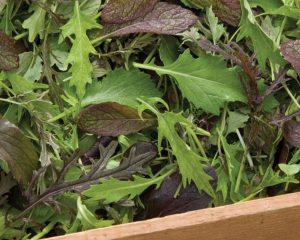 Asian Greens – Asian greens are a diverse group of leafy vegetables, including varieties like bok choy, gai lan, mizuna, and tatsoi, known for their tender leaves and mild, slightly peppery flavors. They are rich in vitamins A, C, and K, as well as antioxidants and fiber, making them a nutritious addition to meals. These greens are versatile and can be enjoyed raw in salads, stir-fried, steamed, or added to soups and noodle dishes. Store Asian greens in the refrigerator, ideally in a plastic bag or container with a damp paper towel to maintain freshness, and use them within a week for the best quality.
Asian Greens – Asian greens are a diverse group of leafy vegetables, including varieties like bok choy, gai lan, mizuna, and tatsoi, known for their tender leaves and mild, slightly peppery flavors. They are rich in vitamins A, C, and K, as well as antioxidants and fiber, making them a nutritious addition to meals. These greens are versatile and can be enjoyed raw in salads, stir-fried, steamed, or added to soups and noodle dishes. Store Asian greens in the refrigerator, ideally in a plastic bag or container with a damp paper towel to maintain freshness, and use them within a week for the best quality.
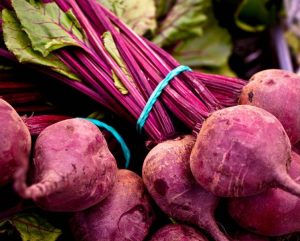 Beet, Red – Red beets are root vegetables known for their earthy flavor and vibrant red-purple color. They are rich in nutrients like folate, manganese, potassium, dietary fiber, and antioxidants such as betalains, which help reduce inflammation and support heart health. Both the roots and greens are edible, with the greens offering additional nutrients like vitamins A and C. Beets can be eaten raw in salads, roasted, boiled, or blended into smoothies and soups. Store beet greens separately from the root, wrapped in a damp cloth or in a plastic bag in the fridge. Use within a few days – they don’t keep long. Beetroots can be stored in a plastic bag in the fridge’s crisper drawer for up to two weeks. To freeze beets for longer storage, slice or chop them, spread on a cookie sheet to flash freeze, then transfer to freezer bags where they can be stored for up to a year.
Beet, Red – Red beets are root vegetables known for their earthy flavor and vibrant red-purple color. They are rich in nutrients like folate, manganese, potassium, dietary fiber, and antioxidants such as betalains, which help reduce inflammation and support heart health. Both the roots and greens are edible, with the greens offering additional nutrients like vitamins A and C. Beets can be eaten raw in salads, roasted, boiled, or blended into smoothies and soups. Store beet greens separately from the root, wrapped in a damp cloth or in a plastic bag in the fridge. Use within a few days – they don’t keep long. Beetroots can be stored in a plastic bag in the fridge’s crisper drawer for up to two weeks. To freeze beets for longer storage, slice or chop them, spread on a cookie sheet to flash freeze, then transfer to freezer bags where they can be stored for up to a year.
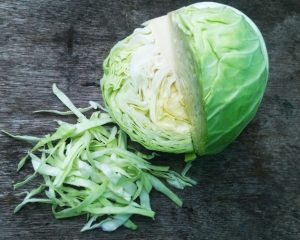 Cabbage, Green – Green cabbage is a nutrient-dense cruciferous vegetable in the Brassica family, known for its tightly packed, round, pale green leaves. It is rich in vitamins C and K, as well as fiber and antioxidants, which are beneficial for immune health, digestion, and bone strength. With a mild, slightly peppery taste, green cabbage can be enjoyed raw in salads and slaws, or cooked in stir-fries, soups, and stews. To store, keep green cabbage unwashed in a perforated plastic bag in the refrigerator’s crisper drawer, where it can stay fresh for up to two weeks.
Cabbage, Green – Green cabbage is a nutrient-dense cruciferous vegetable in the Brassica family, known for its tightly packed, round, pale green leaves. It is rich in vitamins C and K, as well as fiber and antioxidants, which are beneficial for immune health, digestion, and bone strength. With a mild, slightly peppery taste, green cabbage can be enjoyed raw in salads and slaws, or cooked in stir-fries, soups, and stews. To store, keep green cabbage unwashed in a perforated plastic bag in the refrigerator’s crisper drawer, where it can stay fresh for up to two weeks.
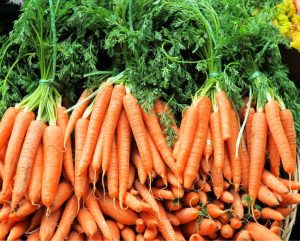 Carrot – Carrots are a versatile and popular root vegetable, known for their sweet, crunchy texture and vibrant orange color, though they can also be found in purple, yellow, and red varieties. They are rich in beta-carotene, which the body converts to vitamin A, essential for good vision and immune health. Carrots are a good source of dietary fiber, potassium, and antioxidants. Enjoy them raw, cooked, roasted, or juiced. They can be used in salads, soups, stews, and side dishes. For optimal storage, store carrots unwashed in the fridge, preferably in a plastic bag or container to maintain moisture, where they can last for several weeks. If the greens are attached, cut them off to prevent the carrots from becoming limp. Stored properly, they should last around 1-2 weeks.
Carrot – Carrots are a versatile and popular root vegetable, known for their sweet, crunchy texture and vibrant orange color, though they can also be found in purple, yellow, and red varieties. They are rich in beta-carotene, which the body converts to vitamin A, essential for good vision and immune health. Carrots are a good source of dietary fiber, potassium, and antioxidants. Enjoy them raw, cooked, roasted, or juiced. They can be used in salads, soups, stews, and side dishes. For optimal storage, store carrots unwashed in the fridge, preferably in a plastic bag or container to maintain moisture, where they can last for several weeks. If the greens are attached, cut them off to prevent the carrots from becoming limp. Stored properly, they should last around 1-2 weeks.

Carrot, Rainbow – In addition to the nutritional benefits above, rainbow carrots stand out from standard orange carrots with their vibrant colors—purple, yellow, red, and white—each offering unique nutritional benefits and distinct flavors. Purple carrots contain anthocyanins, powerful antioxidants linked to anti-inflammatory and heart-health benefits, with a slightly earthy, spicy taste. Yellow carrots are rich in lutein, which promotes eye health by protecting against macular degeneration and cataracts, and they have a mild, subtly sweet flavor. Red carrots contain lycopene, a potent antioxidant that supports heart health, reduces the risk of certain cancers, and helps protect skin from UV damage, with a richer, sweeter taste.
These colorful carrots are perfect for adding visual appeal to dishes and enhancing the taste profile, whether roasted to bring out their natural sweetness, or sliced raw for salads. Their distinct flavors can also add depth to juices and smoothies. The diverse hues, flavors, and nutrients of rainbow carrots make them perfect for garnishes or serving as part of a vegetable medley. Store rainbow carrots the same way you would store standard orange carrots.
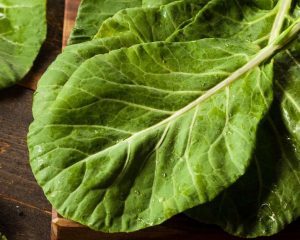 Collard Greens – Collard greens are leafy greens with a slightly bitter, earthy flavor and hearty texture. They are rich in vitamins A, C, and K, calcium, fiber, and antioxidants, which support bone health, immune function, and digestion. Collard greens are often cooked by sautéing, steaming, or simmering in soups and stews, and they’re popular in Southern and African cuisines. Have you used your collard greens to make “lettuce” wraps yet? They hold together better so they are a great substitute. To store, keep collard greens in the refrigerator, wrapped in a damp paper towel inside a plastic bag, where they can stay fresh for up to a week. For longer storage, blanch and freeze them or make green cubes to store for later use.
Collard Greens – Collard greens are leafy greens with a slightly bitter, earthy flavor and hearty texture. They are rich in vitamins A, C, and K, calcium, fiber, and antioxidants, which support bone health, immune function, and digestion. Collard greens are often cooked by sautéing, steaming, or simmering in soups and stews, and they’re popular in Southern and African cuisines. Have you used your collard greens to make “lettuce” wraps yet? They hold together better so they are a great substitute. To store, keep collard greens in the refrigerator, wrapped in a damp paper towel inside a plastic bag, where they can stay fresh for up to a week. For longer storage, blanch and freeze them or make green cubes to store for later use.
 Ginger – Ginger is a flavorful root widely used as a spice and natural remedy. It has a warm, slightly spicy taste and is rich in bioactive compounds like gingerol, which has anti-inflammatory and antioxidant properties. Ginger aids digestion, relieves nausea, and supports immune health. It is versatile in cooking and used in teas, curries, stir-fries, baked goods, and beverages. Store fresh ginger in a cool, dry place for short-term use or in the refrigerator in a paper towel or airtight bag for extended freshness. For long-term storage, freeze peeled or sliced ginger.
Ginger – Ginger is a flavorful root widely used as a spice and natural remedy. It has a warm, slightly spicy taste and is rich in bioactive compounds like gingerol, which has anti-inflammatory and antioxidant properties. Ginger aids digestion, relieves nausea, and supports immune health. It is versatile in cooking and used in teas, curries, stir-fries, baked goods, and beverages. Store fresh ginger in a cool, dry place for short-term use or in the refrigerator in a paper towel or airtight bag for extended freshness. For long-term storage, freeze peeled or sliced ginger.
Freeze your fresh ginger for longer storage: Peel and slice or grate the ginger. Freeze in an airtight container or ice cube tray. You can also freeze the whole unpeeled root in a freezer bag. Grate or slice directly from frozen as needed.
 Green Onions – Green onions, also known as scallions, have a mild, slightly sweet onion flavor and are packed with vitamins A and K. They are often used raw in salads, salsas, and garnishes but also add depth to stir-fries, soups, and omelets. Their green tops and white bulbs are both edible, making them a versatile ingredient. Store in the refrigerator, wrapped in a damp paper towel inside a bag, or stand them in a jar of water to keep them fresh longer.
Green Onions – Green onions, also known as scallions, have a mild, slightly sweet onion flavor and are packed with vitamins A and K. They are often used raw in salads, salsas, and garnishes but also add depth to stir-fries, soups, and omelets. Their green tops and white bulbs are both edible, making them a versatile ingredient. Store in the refrigerator, wrapped in a damp paper towel inside a bag, or stand them in a jar of water to keep them fresh longer.

Kale (Curly) – Curly kale is a nutrient-dense leafy green rich in vitamins A, C, and K, along with fiber, antioxidants, and minerals like calcium and potassium. It has a slightly bitter, peppery flavor and a sturdy texture that softens when massaged, cooked, or blended. Curly kale is great in salads, soups, sautés, smoothies, and as a base for grain bowls. Store unwashed leaves in a loose bag in the fridge’s crisper drawer, ideally wrapped in a damp paper towel, and use within 5–7 days. To keep it fresh longer, blanch and freeze it for later use in cooked dishes.
Fun fact: NASA has studied kale as a potential crop for space missions because of its high nutrient density. Per calorie, kale has more iron than beef and more calcium than milk. And one cup of raw kale has more vitamin C than a whole orange. (But don’t stop eating those other nutrient-packed foods!)
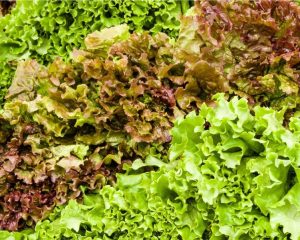
Lettuce, Loose Leaf – Leaf lettuce, known for its loose, leafy structure and mild, slightly sweet flavor, comes in green and red varieties. It is a low-calorie vegetable packed with vitamins A, C, and K, as well as folate and fiber, making it a nutritious choice for salads and wraps. Its tender leaves are best used raw in salads, sandwiches, or as a garnish. Store leaf lettuce in the refrigerator, loosely wrapped in a damp paper towel inside a plastic bag or container, and use it within a week to maintain freshness and crispness.
Mushroom Varieties
Store mushrooms in a paper bag or breathable container in the refrigerator, avoiding moisture buildup, and only wash them right before use to maintain freshness.
Mushrooms are super versatile in the kitchen. Here are 10 Things You Should Do With Mushrooms.
This roundup of 20 Mushroom Recipes has you covered with meal ideas for breakfast, lunch, or dinner.
Mushroom, Portobello & Cremini – Portobello mushrooms are mature versions of cremini mushrooms, offering a meaty texture and rich, earthy flavor. Cremini, also known as “baby bellas,” are younger, smaller, and have a firmer texture with a milder taste. Both are low in calories, fat-free, cholesterol-free, and provide B vitamins, selenium, potassium, and antioxidants. Portobellos are ideal for grilling, roasting, or as a meat substitute in burgers, sandwiches, or stuffed recipes. Creminis are great for sautéing, adding to soups, stir-fries, pasta dishes, or as pizza and salad toppings.
Mushroom, Shiitake – Shiitake mushrooms are prized for their rich, umami flavor and slightly chewy texture, making them a staple in Asian cuisine. They are low in calories, fat-free, and a good source of B vitamins, copper, selenium, and immune-supporting polysaccharides. Shiitakes are versatile and can be sautéed, stir-fried, grilled, or added to soups, stews, and sauces for a depth of flavor. They are popular in dishes like ramen, risotto, and dumplings, and are often used in vegetarian recipes for their meaty texture.
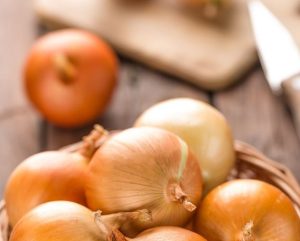
Onion, Yellow – Yellow onions are a popular, versatile vegetable with golden-brown skin and a strong, savory flavor that mellows and sweetens when cooked. Rich in antioxidants, vitamin C, and fiber, yellow onions support immune health, digestion, and overall cellular health. They’re a staple in many cuisines, perfect for sautéing, caramelizing, roasting, and adding depth to soups, stews, and sauces. To store, keep unpeeled yellow onions in a cool, dry, well-ventilated place, away from potatoes, where they can last up to a month; once peeled or cut, store them in an airtight container in the refrigerator for up to a week.
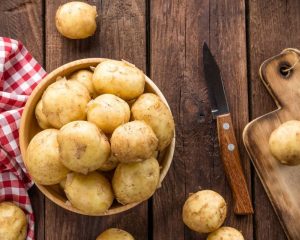 Potato, Yellow – Also known as Yukon Gold or gold potatoes, yellow potatoes have smooth, thin, yellowish skin and creamy, buttery-flavored flesh. They are slightly waxy, making them versatile in cooking. Yellow potatoes are a good source of vitamin C, potassium, and fiber and are low in calories and fat. Their creamy texture makes them ideal for mashing, roasting, grilling, and boiling. They are also excellent in gratins and salads because they hold shape during cooking. Store yellow potatoes in a cool, dark, and well-ventilated place for several weeks, avoiding refrigeration as it can alter their texture and flavor.
Potato, Yellow – Also known as Yukon Gold or gold potatoes, yellow potatoes have smooth, thin, yellowish skin and creamy, buttery-flavored flesh. They are slightly waxy, making them versatile in cooking. Yellow potatoes are a good source of vitamin C, potassium, and fiber and are low in calories and fat. Their creamy texture makes them ideal for mashing, roasting, grilling, and boiling. They are also excellent in gratins and salads because they hold shape during cooking. Store yellow potatoes in a cool, dark, and well-ventilated place for several weeks, avoiding refrigeration as it can alter their texture and flavor.
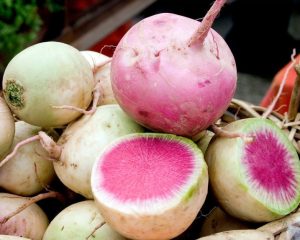 Radish, Watermelon – Watermelon radish is a striking root vegetable with a mild, slightly sweet flavor and a crisp texture. Its pale green skin hides a vibrant pink interior, resembling a watermelon. Rich in vitamin C, potassium, and antioxidants, it supports immune health and reduces inflammation. Watermelon radishes can be enjoyed raw in salads, sliced thinly for garnishes, pickled, or roasted for a milder flavor. Store unwashed watermelon radishes in a perforated plastic bag in the refrigerator, where they can stay fresh for up to two weeks. Wash and trim just before using.
Radish, Watermelon – Watermelon radish is a striking root vegetable with a mild, slightly sweet flavor and a crisp texture. Its pale green skin hides a vibrant pink interior, resembling a watermelon. Rich in vitamin C, potassium, and antioxidants, it supports immune health and reduces inflammation. Watermelon radishes can be enjoyed raw in salads, sliced thinly for garnishes, pickled, or roasted for a milder flavor. Store unwashed watermelon radishes in a perforated plastic bag in the refrigerator, where they can stay fresh for up to two weeks. Wash and trim just before using.
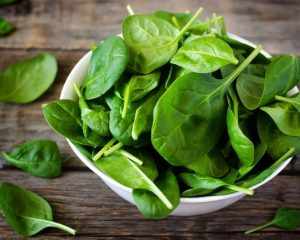 Spinach – Spinach is a nutrient-rich leafy green vegetable packed with vitamins A, C, K, and folate, along with minerals like iron and magnesium. Low in calories and high in antioxidants, it supports eye health, bone strength, and immune function. Spinach is versatile and can be enjoyed raw in salads, blended into smoothies, or cooked in soups, pasta, and omelets. To store, keep it dry in a perforated plastic bag in the fridge’s crisper drawer, and wash only before use. Properly stored, it stays fresh for 5-7 days.
Spinach – Spinach is a nutrient-rich leafy green vegetable packed with vitamins A, C, K, and folate, along with minerals like iron and magnesium. Low in calories and high in antioxidants, it supports eye health, bone strength, and immune function. Spinach is versatile and can be enjoyed raw in salads, blended into smoothies, or cooked in soups, pasta, and omelets. To store, keep it dry in a perforated plastic bag in the fridge’s crisper drawer, and wash only before use. Properly stored, it stays fresh for 5-7 days.
 Sweet Potato – Sweet potatoes are a nutritious root vegetable known for their naturally sweet flavor and vibrant orange flesh, though they also come in other colors like purple and white. They are rich in vitamins A (as beta-carotene), C, and B6, as well as dietary fiber, potassium, and antioxidants. These nutrients support eye health, boost immunity, and promote digestive health. Sweet potatoes are versatile in cooking and can be baked, roasted, mashed, or used in soups and stews. They can also be enjoyed in both savory and sweet dishes. Store sweet potatoes in a cool, dark, well-ventilated place for several weeks, avoiding refrigeration as it can affect their texture and flavor.
Sweet Potato – Sweet potatoes are a nutritious root vegetable known for their naturally sweet flavor and vibrant orange flesh, though they also come in other colors like purple and white. They are rich in vitamins A (as beta-carotene), C, and B6, as well as dietary fiber, potassium, and antioxidants. These nutrients support eye health, boost immunity, and promote digestive health. Sweet potatoes are versatile in cooking and can be baked, roasted, mashed, or used in soups and stews. They can also be enjoyed in both savory and sweet dishes. Store sweet potatoes in a cool, dark, well-ventilated place for several weeks, avoiding refrigeration as it can affect their texture and flavor.
 Sweet Potato, Fingerling – Sweet potato fingerlings are small, slender sweet potatoes with thin, edible skin and a naturally sweet, creamy texture. They are rich in fiber, beta-carotene, and vitamin C, promoting digestive and immune health. Roast, sauté, or air-fry them whole for a crispy skin and tender interior, or slice them into fries or hash. Store in a cool, dry place away from light, but avoid refrigeration as it can affect their texture.
Sweet Potato, Fingerling – Sweet potato fingerlings are small, slender sweet potatoes with thin, edible skin and a naturally sweet, creamy texture. They are rich in fiber, beta-carotene, and vitamin C, promoting digestive and immune health. Roast, sauté, or air-fry them whole for a crispy skin and tender interior, or slice them into fries or hash. Store in a cool, dry place away from light, but avoid refrigeration as it can affect their texture.
 Swiss Chard (baby) – Milder and more tender than mature Swiss chard, baby chard is often used raw in salads, wraps, or grain bowls. While still rich in vitamins A, C, and K, it may have slightly less fiber than its fully grown counterpart. Store in a sealed container with a dry paper towel in the fridge and use within 3–5 days for the best freshness.
Swiss Chard (baby) – Milder and more tender than mature Swiss chard, baby chard is often used raw in salads, wraps, or grain bowls. While still rich in vitamins A, C, and K, it may have slightly less fiber than its fully grown counterpart. Store in a sealed container with a dry paper towel in the fridge and use within 3–5 days for the best freshness.
Fun fact: Chard is in the chenopod family which includes beets, spinach, and quinoa.
Don’t Forget: Online shopping opens Friday at 1 PM! 🛒 Stock your kitchen with these clean, nourishing ingredients to fuel your family with nutrient-dense meals. Be sure to grab your favorite staples and try something new for vibrant health this winter.
Don’t wait to join…
Veggie E-Books
Download these collections of tips and recipes for each veggie. You’ll use these as a reference throughout the season.
Arugula E-Book
Beets E-Book
Carrots E-Book
Collard Greens E-Book
Kale E-Book
Lettuce E-Book
Mushrooms E-Book
Onions E-Book
Potatoes E-Book
Radish E-Book
Scallion/Green Onion E-Book
Spinach E-Book
Swiss Chard E-Book
~~~~~
Farm News and Events
Learn The Art of Pysanky Egg Decorating
Pysanky is an ancient Ukrainian tradition that celebrates the cycles of nature and life, using motifs inspired by these themes. Designs are created with simple tools like kistkas, beeswax, candlelight, and vibrant dyes, This workshop invites participants to explore the craft in a freeform style, using symbolism to tell a specific story and hold a deliberate intention.
Join us Saturday, March 22, 2025, from 9:00 AM – 12:00 PM and create a symbolic piece of art believed to bring Peace!
- Cost: $40 per session – all supplies will be provided.
All profits will be donated to Ukranian Peace Missions. - Please bring your own container to take your egg home.
- Registration is required. Space is limited to 12 individuals.
Register in person at Willow Haven Farm General Store, or by emailing WHFGeneralStore@gmail.com.
Ages 12 and up ONLY.
~~~~~
🍞 Only 5 spots left : Sourdough Bread Baking Workshop – Sign Up!
Get ready for a fun, hands-on experience in the art of sourdough bread making!
Join us on Saturday, March 29, 2025, for our Sourdough Bread Baking Workshop at Willow Haven Farm.
Whether you’re a beginner or a seasoned baker, this workshop will give you the skills and confidence to bake delicious, homemade sourdough bread from scratch.
 👩🍳 What to Expect on March 29th:
👩🍳 What to Expect on March 29th:
- Step-by-step guidance from our expert instructor
- Hands-on experience making your own sourdough starter
- Tips for perfecting your bread at home
- A chance to meet other bread enthusiasts in a fun, relaxed environment
✨ Don’t miss out on this opportunity to take your baking to the next level!
We’ll keep farming for you!
Reuben and Tessa DeMaster
Willow Haven Farm


